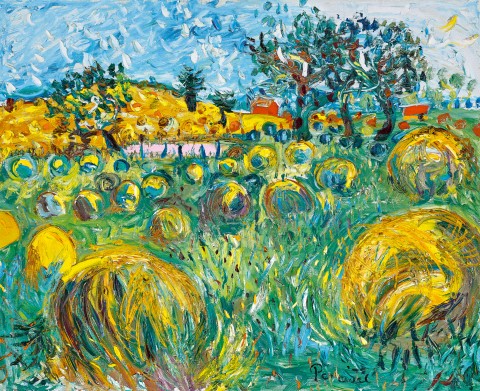HAYSTACKS, 1972
JOHN PERCEVAL
oil on canvas
96.0 x 119.0 cm
signed and dated lower right: '72 / Perceval
bears inscription verso: Haystacks
South Yarra Gallery, Melbourne
Barry Stern Gallery, Sydney, January 1980
Tolarno Galleries, Melbourne
The National Australia Bank Art Collection, acquired from the above in 1981 (label attached verso)
Recent Works by John Perceval, South Yarra Gallery, Melbourne, 17 October 1972, cat. 2 (illus. front cover of exhibition catalogue)
John Perceval, South Yarra Gallery, Melbourne, 20 February 1976
The Seventies: Australian Paintings and Tapestries from the Collection of National Australia Bank, National Gallery of Victoria, Melbourne, 15 October – 28 November 1982
Collection of Modern Art in the Seventies, Latrobe Valley Arts Centre, Victoria, 9 May - 2 June 1985
Australian Pavilion at the World Expo '88, Australian Pavilion, Brisbane, 7 April - 4 November 1988
The Seventies Exhibition: Selected Paintings from the National Australia Bank Collection, MacLaurin Hall, The University of Sydney, Sydney, 6 September - 1 October 1989, cat. 28 (illus. exhibition catalogue cover)
The Seventies: Contemporary Australian Paintings from the National Australia Bank Collection, organised by Regional Galleries Association of New South Wales, New South Wales, cat. 22 (illus. exhibition catalogue cover); and touring, Tamworth City Art Gallery, New South Wales, 24 May – 24 June 1990; Dubbo Regional Art Gallery, New South Wales, 11 July – 6 August 1990; Wagga Wagga City Art Gallery, New South Wales, 17 August – 10 September 1990; Moree Plains Regional Gallery, New South Wales, 3 October – 31 October 1990
John Perceval: A Retrospective Exhibition, National Gallery of Victoria, Melbourne, 30 April – 12 July 1992, Art Gallery of New South Wales, Sydney, 6 August – 20 September 1992 (label attached verso)
Art and Australia, Ure Smith, Sydney, vol. 10, no. 1, July 1972, p. 11 (illus., as ‘Haystacks Near Berwick’)
Lindsay, R., The Seventies: Australian Paintings and Tapestries from the Collection of National Australia Bank, The National Bank of Australasia, Melbourne, 1982, pl. 73, p. 86 (illus.)
'Insight into Recent Art', The Express, Victoria, 2 May 1985, p. 12
'First Public Display in Sydney of National's Paintings' The University of Sydney News, Sydney, vol. 21, no. 20, 1 August 1989, p. 170 (illus.)
Fenner, F., 'The Good Life: Paintings lost in the 70s', Tamworth Daily Leader, New South Wales, 1 June 1990
Fischbein, J., 'Saluting the Seventies', Look, Sydney, July 1990, p. 16 (illus.)
Allen, T., John Perceval, Melbourne University Press, Victoria, 1992, p. 171
Haystacks, 1975, Aubusson tapestry, 160.0 x 195.0 cm, location unknown, illus. in Art and Australia, Ure Smith, Sydney, vol. 13, no. 2, October – December 1975, p. 126
11112.jpg

In the early 1970s, John Perceval undertook a large cycle of paintings that revisited memories from his childhood. He had adopted a similar approach earlier in the 1940s, in a sequence of haunting works unavoidably affected by the psychological effect of the Second World War. By comparison, the later images are more joyous and a list of works from 1971 – 72 reveal some eighteen paintings with the word ‘wheatfield’ in the title. Perceval had a fractured childhood due to his parents’ divorce and his affliction with polio at age fifteen but until the age of eleven, he lived with his father who ran ‘a six-thousand-acre wheat and sheep farm in the shire of Merredin, two hundred and twenty kilometres east of Perth. The nearest town, Merredin itself, was small and remote, with one main road. Horses and carts clattered across its flatness.’1 It is this landscape and the memories evoked which underscore Haystacks, 1972.
Whilst recuperating from polio, Perceval discovered the work of van Gogh, and was immediately inspired by the Dutchman’s vibrant approach and evident rapport with his subjects. Perceval’s mature style was equally compelling, full of rich textural brush marks and jewel-like colour, but by then he had also absorbed other ideas and inspiration, most notably through the work of Northern Renaissance artists such as Pieter Bruegel and in the ceramics he created with Arthur Boyd. Georges Mora, who advised the National Australia Bank on many of its purchases, described Perceval’s imagery as being ‘very near reality [though] it has no laboured evolution or intention to be exact. (Exactitude in Art is, anyhow, not necessarily the truth.) But his lines are rhythmic and powerful…radiant and sensual.’2 By 1972, however, Perceval’s years of hard living, alcohol consumption and psychiatric disorders were becoming more apparent and it would seem that this return to imagery based upon his Western Australian childhood was a dedicated attempt to restore a contemplative ‘anchor’ to his life.
Haystacks was exhibited at the South Yarra Gallery in Melbourne in 1972 alongside related works such as Boy in a wheatfield and Farmer in a wheatfield smoking a pipe, both from 1971. All are looser in technique than previous paintings by Perceval, evidence of the foment of ideas and memories tumbling out of his consciousness as the series progressed. He often painted en plein air with artists such as Fred Williams, Albert Tucker, and Clifton Pugh, who later described his colleague’s technique: ‘[Perceval’s] original layer was worked tonally with back, middle and foreground spaces, over which was placed the abstract expressionist layer of patterned impasto.’3 This strategy is immediately apparent in Haystacks and the overlaying ‘patterned impasto’ agitates the whole surface causing the scene to oscillate in and out of focus as the eye traverses the image, particularly in the passages of wheat stalks laid bare between the rolls of baled hay. Although absent of people, Haystacks obviously had an important resonance for the artist as he had it reworked into a large tapestry at the UNESCO-listed Aubusson workshops in central France in 1975.
1. Allen, T., John Perceval, Melbourne University Press, Victoria, 1992, pp.5-6
2. Mora, G., ‘Foreword’ in John Perceval: drawings 1940-1950, Tolarno Galleries, Melbourne, 10 August – 4 September 1977
3. Clifton Pugh, 1988 cited in Allen, ibid., p.139
ANDREW GAYNOR
